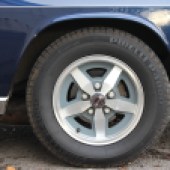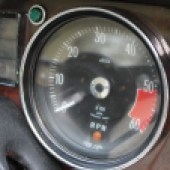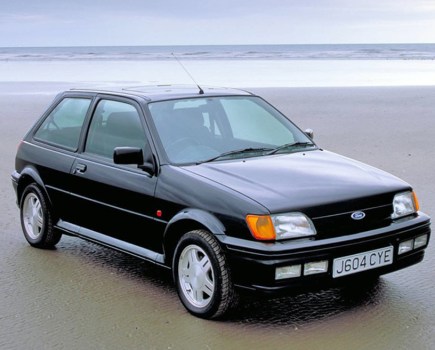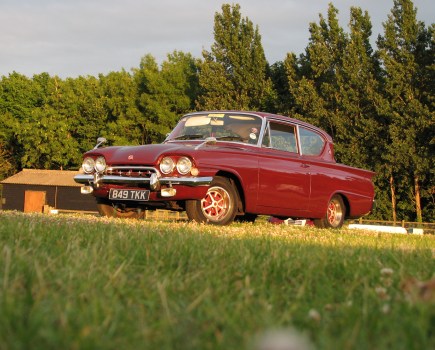The Jensen Interceptor is handsome, powerful and brimming with character. Here’s how to buy a great example of this Anglo-American 70s GT
Sponsored editorial in association with Lancaster Insurance
Born out of fierce disputes in the boardroom, the Jensen Interceptor endured a troubled beginning. Yet despite its rocky start – and the financial turbulence that would later engulf Jensen itself – the car went on to cement its place as one of Britain’s most admired grand tourers, remembered fondly long after the company’s decline.
At the heart of those early disagreements was its striking silhouette. Originally styled by Carrozzeria Touring and later refined by Vignale, the Interceptor’s dramatic profile – complete with that unmistakable glass tailgate – proved as divisive in period as it is adored today. But the appeal wasn’t just skin-deep; beneath those bold lines lay mechanicals that gave the car real substance.
Much of the running gear carried over from the outgoing C-V8, including a thundering 6,276cc Chrysler V8. Alongside it sat the advanced FF model, boasting Ferguson’s four-wheel drive system – a groundbreaking flagship, though ultimately too costly to sustain. Its place was later taken by the SP, a rear-driven variant powered by Chrysler’s muscular 7.2-litre V8 with triple carburettors. By 1971, the smaller 6.3-litre unit was dropped, meaning all standard Interceptors gained the bigger engine too, albeit in single-carb form.
For this guide, we’ll place emphasis on the 6.3-litre Interceptor – a car that John Pym of the Jensen Owners’ Club knows inside-out – though much of the insight applies equally to later derivatives.

Jensen Interceptor values
Interceptor values vary widely depending on condition, originality and history. Project cars still surface from around £15,000-£20,000, but restoration costs can easily exceed the finished value. Usable, presentable examples typically command £35,000, offering the best balance between affordability and enjoyment. The finest cars – low-mileage, fully restored or with desirable provenance – now reach £70,000-£90,000. As with many classics, buying the best you can afford usually makes the most financial sense.
Insurance Costs
1972 Jensen Interceptor, £38,000 value.
Example quote: £202.85 or £220.85 with Agreed Value.Quotation supplied by Lancaster Insurance. Tel: 01480 400761
Quote based on a 45-year-old marketing manager, access to another car, no claims or convictions, club member, 3000 miles per year, no modifications, living in SP2 0HL. Disclaimer: Subject to underwriting criteria. An additional charge may be payable. Authorised and regulated by the Financial Conduct Authority.
Bodywork
Let’s begin with the biggest – though hardly unexpected – issue: rust. As with most cars of this vintage, corrosion can affect virtually any Interceptor, so a thorough inspection is essential when viewing one for sale. Wheelarches are a well-known weak spot, as are the front and rear valances, but it’s the inner sills that can deliver the nastiest surprises. As John Pym explains: “They’re hidden by an outer sill that’s purely cosmetic, which in turn is covered by a stainless steel trim along the bottom of the car. You have to remove both to reach the inner sill, where water often becomes trapped. Because it’s a structural section, repairs can run to around £4000 per side if they’ve already rusted through.” That said, outer sill panels cost just £85 each and inner sills will run you around £385 a side, so if you’re confident with the welder, the whole job could set you back less than half that with some patience.
The Interceptor’s distinctive glass tailgate is another area to watch, particularly in Britain’s unforgiving climate. Supported only by two hinges at the top, it can quickly suffer if the weather has begun to take its toll, so any deterioration there needs dealing with straightaway.
If you do uncover a few panels in need of attention, it’s not necessarily a deal-breaker – but you must factor the repair costs into your budget and use them as leverage when agreeing a price. Thankfully, several UK suppliers still have access to Jensen’s original presses, meaning replacement panels aren’t usually hard to source. One exception, however, is the roof: if corrosion has taken hold there, it’s best to walk away.
Engine and transmission
The Chrysler V8 is a robust unit with few inherent weaknesses. Minor oil leaks are commonplace on Interceptors, while the sheer heat generated in the engine bay can lead to wiring looms becoming brittle and crusty with age. If either issue appears more serious than the usual wear and tear, it will need sorting promptly.
The carburettor will almost certainly have needed a rebuild within the last decade or so, so it’s worth checking the history file for evidence. Another known issue is debris in the sump, as small fragments of plastic from ageing components can break off and block the oil pump. A lumpy idle or uneven running can also point to hydraulic tappets being clogged with residue, restricting valve operation.
“In truth, they’re pretty bulletproof,” Pym reassures. “They’ll happily run on unleaded, too. As long as servicing has been kept on top of, they’re generally very reliable.”
Transmission-wise, the Interceptor employs the period-favourite three-speed Torqueflite automatic paired with a Powr-Lok limited-slip differential. The priority check is the transmission fluid: it should be bright red, free of particles, and with no sign of leaks. The history file should also confirm that the filter has been replaced within the past five years.
“If it’s not shifting smoothly, the gearbox bands can be tightened, but if that doesn’t cure it then it’s rebuild time – about £1500,” Pym advises. “That said, they’re dependable if the oil and filter are kept fresh, and most cars will have had a rebuild at some stage in the last half-century anyway.” Conversion to the later GM 4L60E four-speed is possible, but the unit – used primarily in Corvettes and Camaros – is rare in the UK and will likely run you more than simply rebuilding the original transmission.

Suspension, steering and brakes
At the front of the car, you’ll find a set of double wishbones with springs and shocks, while at the rear there’s a solid live axle on leaf springs. “The rear leaf springs often sag under the weight of the car,” explains John, “so the best solution is either to replace them or have them re-tempered.” It’s worth noting, a replacement rear leaf spring set from britishclassiccarparts.com will run you a hefty £770 delivered…
“Replacement dampers are also easy enough to source. A useful upgrade is fitting coilovers at the back, which relieves some of the load from the springs and restores a proper ride height. They also help the car remain more composed under hard acceleration, whereas the original set-up has a tendency to squat.”
A notably advanced feature of the Interceptor for its era is the braking system. Even the earliest models were equipped with discs all round, with later versions benefitting from ventilated units. Make sure to inspect discs and pads for excessive wear, and don’t overlook the condition of the brake hoses and pipework.
Interior and trim
The Interceptor is a genuine four-seater, offering a surprisingly generous cabin for what is essentially a high-end sporting GT. “Once you’re in the back it’s perfectly comfortable, though legroom can be tight if the driver happens to be tall,” explains Pym. “From behind the wheel though, it’s very accommodating – there’s plenty of adjustment and it suits drivers of all shapes and sizes. I know two owners who are six foot six and they fit without issue.”
When it comes to buying, interior condition largely comes down to wear and tear. The driver’s seat bolsters are prone to scuffing and the foam tends to collapse with age. Fortunately, as with the body panels, most trim and soft furnishings are available new, meaning replacements aren’t difficult to source. The real sting is in the bill if a full retrim is required. “For a professional job you’re looking at somewhere between £5000 and £8000,” Pym cautions.
The dashboard, on the other hand, is a trickier area – damaged trim here can be difficult, if not impossible, to replace. Always check the instruments and switches are functioning as they should. Cars equipped with air conditioning also need extra scrutiny; ensure it works properly, as a new system can cost around £1000 if you want to fit an upgraded setup. One final detail is the tailgate release. Operated by a lever near the driver’s door, it relies on a cable which can snap – if it does, you’ll have no access to the boot. Always test it before committing.

Jensen Interceptor: our verdict
It’s difficult not to be captivated by the Interceptor’s intoxicating blend of robust, torque-laden Mopar power wrapped in a stylish yet usable body. As a true all-rounder, it feels like the sort of car that could easily justify a one-car classic garage. Prices are undeniably strong today, but few machines deliver quite the same experience – and you’ll always attract just the right balance of curiosity and admiration at any classic gathering.
Having cherished his Interceptor for over eleven years, owner John Pym has a deep understanding of what it’s really like to live with one. “It was considered a big car in its time, but behind the wheel today it actually feels quite nimble,” he says. “You wouldn’t choose to thread it along twisting B-roads all day, but it’s perfectly manageable in town. It’s not the sort of car that would ever feel like a burden in daily use.”
Jensen Interceptor timeline
1969
Production moves fully to West Bromwich, with refinements to trim and mechanicals.
1971
Series II is launched with subtle styling tweaks and improved interior appointments.
1974
The Series III appears, featuring a larger 7.2-litre Chrysler V8 in most markets, plus better equipment.
1976
Interceptor production ends, following dwindling sales due to economic pressures and the fuel crisis. Production totals 6408 cars.





















